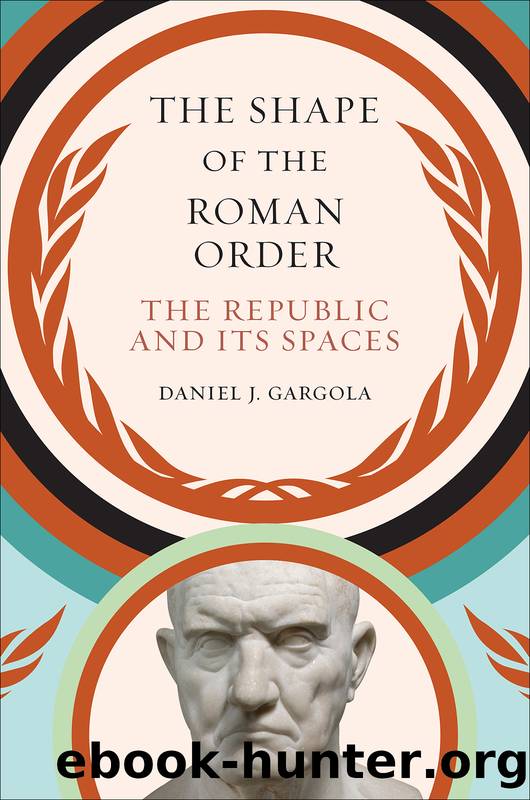The Shape of the Roman Order by Daniel J. Gargola

Author:Daniel J. Gargola [Gargola, Daniel J.]
Language: eng
Format: epub
ISBN: 9781469631820
Publisher: UNC Press
Published: 2017-09-15T05:00:00+00:00
INSIDE AND OUTSIDE
Over time, the augurs established a nested series of spaces that took on its developed form in the third century. Within the city and near to it, they created under the supervision of magistrates inaugurated places that served to frame important activities. They also built out zones from the city, bounded by the pomerium, the outer limits of their ager Romanus, the territories that had come into Roman hands, and finally the lands of their enemies and the frequent scene of military operations. In this way, augural practice was but a specific instance of a broader tendency to build zones around Rome or occasionally other centers as well, which we have encountered informally in the distribution of statuses and official roles and in the acknowledgment of prodigies and will later encounter with greater formality in laws, edicts, and decrees. Like the early significance of provincia, these augural zones concerned magistrates and their ability to act and move legitimately rather than the peoples or polities encompassed within them. Terra Italia, with its boundaries at the Aesis and Arnus Rivers, constituted a still larger zone, although its augural consequences are uncertain.
These spaces and zones, moreover, were connected to a valuation in which the inner was preferred or emphasized over the outer, a feature that we will later encounter in Roman legislation as well. In the small spaces, templa, that the augurs constituted in and about Rome, they performed the operations of a liberatio and an effatio, which defined their limits and removed unwanted spiritual influences from their interiors; later operations might impose a law or laws on these spaces. (Although they were not templa, the clearings at the center of sacred groves were more important than the woods that surrounded them and separated them from the outside world, and they too might be regulated by laws.)117
Although the urbs was not a templumâprofane activities did take place in itâthe pomerium excluded matters relating to war, and magistrates, priests, and the senate might prohibit others in certain circumstances: the Twelve Tables, for example, barred burials within the urbs, while on a number of occasions during the first century priests of Isis and cult places dedicated to her were ordered removed from the urbs or even the Capitol.118 A purification of the urbs (lustratio urbis) was one of the most common rituals used to expiate prodigies, while other rites, such as that of the Argei, closely connected to the four urban regions, performed the same broad function in different contexts.119 Special powers, moreover, might be attributed from time to time to religious functionaries within it: Pliny (HN 28.13) claims that the Vestals might fix the feet of runaway slaves there. (By the late republic, if not earlier, Roman legislators thought that some of these rules were appropriate to other settlements as well: the authors of the lex coloniae Iuliae Genetivae banned burials from within âboundaries of the town where the plow was led around,â while decurions, augurs, and pontiffs were to have their domiciles within the urbs or within a mile of it unless they had received a special exemption.
Download
This site does not store any files on its server. We only index and link to content provided by other sites. Please contact the content providers to delete copyright contents if any and email us, we'll remove relevant links or contents immediately.
The Daily Stoic by Holiday Ryan & Hanselman Stephen(3266)
The Fate of Rome: Climate, Disease, and the End of an Empire (The Princeton History of the Ancient World) by Kyle Harper(3035)
People of the Earth: An Introduction to World Prehistory by Dr. Brian Fagan & Nadia Durrani(2711)
Ancient Worlds by Michael Scott(2653)
Babylon's Ark by Lawrence Anthony(2650)
The Daily Stoic by Ryan Holiday & Stephen Hanselman(2528)
Foreign Devils on the Silk Road: The Search for the Lost Treasures of Central Asia by Peter Hopkirk(2445)
India's Ancient Past by R.S. Sharma(2433)
MOSES THE EGYPTIAN by Jan Assmann(2395)
The Complete Dead Sea Scrolls in English (7th Edition) (Penguin Classics) by Geza Vermes(2258)
Lost Technologies of Ancient Egypt by Christopher Dunn(2208)
The Earth Chronicles Handbook by Zecharia Sitchin(2204)
24 Hours in Ancient Rome by Philip Matyszak(2065)
Alexander the Great by Philip Freeman(2045)
Aztec by Gary Jennings(1996)
The Nine Waves of Creation by Carl Johan Calleman(1898)
Curse Tablets and Binding Spells from the Ancient World by Gager John G.;(1853)
Before Atlantis by Frank Joseph(1832)
Earthmare: The Lost Book of Wars by Cergat(1807)
